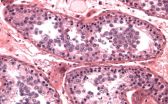(Press-News.org) JILA researchers have designed a microscope instrument so stable that it can accurately measure the 3D movement of individual molecules over many hours--hundreds of times longer than the current limit measured in seconds.*
The technology was designed to track the machinery of biological cells, down to the tiniest bits of DNA, a single "base pair" of nucleotides among the 3 billion of these chemical units in human genes. But the instrument could be useful well beyond biology, biochemistry and biophysics, perhaps in manufacturing.
JILA is a partnership of the National Institute of Standards and Technology (NIST) and the University of Colorado Boulder.
"This technology can actively stabilize two items relative to each other with a precision well below one nanometer at room temperature," JILA/NIST physicist Tom Perkins says. "This level of 3D stability may start to interest the nanomanufacturing world, when they look at making and characterizing things on the single-nanometer scale."
The work builds on JILA's world-leading expertise in measuring positions of microscopic objects. The latest tweaks extend stability for a much longer time period, many hours at a time. With the longer observation times, researchers can see more successive steps of molecular motors, for instance. These biochemical processes are responsible for a broad range of movement in living organisms, including moving molecules around the interior of a cell or copying DNA into another form of genetic material, RNA. The new JILA instrument also can aid in measuring individual proteins as they fold into specific positions, a process required for them to work properly.
Until now, researchers had difficulty detecting more than a few individual, one-base-pair steps in succession before instrumental "drift" would blur the signal. Observing such sets of repetitive steps is very rare. The instrument must be stable to within about one-tenth of a nanometer (1 angstrom to biologists, equivalent to the diameter of a hydrogen atom).
Typically, a microscope can only occasionally achieve this level of stability. But when augmented by the new JILA measurement platform, it can reliably achieve tenth of a nanometer stability for up to 100 seconds at a time. And it can do this over and over again for extended periods--the JILA team operated the system for up to 28 hours straight.
In addition to its high precision and stability, the instrument can detect motion over a wide range of time scales, critical for calibrating instruments and measuring short-lived states in protein folding. The JILA method can be applied to optical trapping techniques, atomic force microscopes and super-resolution imaging.
The method uses two lasers to measure the positions of opposite ends of a molecule, or two different objects, based on the intensity of scattered light. The scattered light is detected by a common photodiode, and the signals are digitized, analyzed and used to calculate the positions of the samples. Crucially, the JILA team verified the stability of the technique by using the two lasers to make two separate, independent measurements of a single sample. Without this confirmation, researchers can't determine if it is the sample or the lasers moving, Perkins explains.
"This technology excites me because it opens the door to measuring the tiniest protein motions," Perkins says."
INFORMATION:
The research was supported by the National Science Foundation and NIST.
* R. Walder, D.H. Paik, M.S. Bull, C. Sauer and T.T.Perkins. Ultrastable measurement platform: sub-nm drift over hours in 3D at room temperature. Optics Express. Vol. 23, Issue 13, 2015. pp. 16554-16564. DOI: 10.1364/OE.23.016554.
See also: http://www.nist.gov/pml/div685/afm_032409.cfm
GRAND RAPIDS, Mich., June 24, 2015 - Researchers at Spectrum Health Helen DeVos Children's Hospital have completed the first clinical trial of a new treatment for children suffering from neuroblastoma. In a clinical trial led by Giselle Sholler, MD, pediatric oncologist at Helen DeVos Children's Hospital and the Neuroblastoma and Medulloblastoma Translational Research Consortium (NMTRC), DFMO, an investigational agent, showed minimal side effects with long-term survival of three patients. This is the first clinical study of an oral dosing form of DFMO in any pediatric population. ...
Scientists have at their disposal a way to explore the possible prevention of genetic diseases before birth. But should they? Currently, the most promising path forward involves editing the genes of human embryos, a procedure rife with controversy. An article in Chemical & Engineering News (C&EN), the weekly newsmagazine of the American Chemical Society, parses the explosive issue.
Britt E. Erickson, a senior editor at C&EN, reports that at least one team of scientists has already published a study on altering disease-related genes of human embryos. The experiment was ...
In the most severe form of male infertility, men do not make any measurable levels of sperm. This condition, called azoospermia, affects approximately 1 percent of the male population and is responsible for about a sixth of cases of male infertility.
Oftentimes men with azoospermia don't know the underlying cause of their condition. But new research led by University of Pennsylvania scientists suggests that mutations in an X chromosome gene called TEX11 are responsible for a significant number of cases of infertility -- an estimated 1 percent of cases of non-obstructive ...
Complex magnetic structures are at the heart of promising new materials for devices in "spintronics", a field of research aiming at more energy efficient data storage and processing. A prominent example is the so-called spin valve, where the magnitude of the electrical current passing through a device is very sensitively dependent on its magnetic configuration. These configurations can be readily controlled by a magnetic field in artificial layer systems, resulting in the giant magnetoresistance effect (GMR), a discovery rewarded with the 2007 Noble price in physics to ...
College Park, Md. -- Extreme heat and precipitation events, which are expected to increase in frequency and intensity due to climate change, are associated with increased risk of Salmonella infections, according to a study led by researchers from the University of Maryland School of Public Health. The study is the first to provide empirical evidence that Salmonella infections related to extreme weather events are disproportionately impacting those living in the coastal areas of Maryland.
"We found that extremely hot days and periods of extreme rainfall are contributing ...
When ecologists gather in Baltimore, Md., this August for the 100th Annual Meeting of the Ecological Society of America, special attention will fall on the local Chesapeake Bay watershed, with field trips and research presentations exploring its rich wildlife and social history. At symposia, poster exhibits, and site visits, ecologists will have opportunities to discuss the latest research and experiences working with stakeholders in the region to improve the health of the nation's largest estuary.
Chesapeake Bay bears a heavy pollution burden from the growing metropolitan ...
PHILADELPHIA - Despite findings of previous studies and published guidelines, nearly two-thirds of patients with T4a larynx ("voice box") cancer are not receiving a total laryngectomy (surgical removal of the larynx), the recommended form of treatment, and as a result, have significantly worse survival rates versus those treated with a total laryngectomy, a new study published in the International Journal of Radiation Oncology, Biology and Physics by experts at Penn Medicine found. Patients who underwent a laryngectomy, on average, lived nearly two years longer than those ...
From today (1 July 2015) The BMJ requires sharing of individual patient data for all clinical trials.
This means that trials will be considered for publication only if the authors agree to make the relevant anonymised patient level data available on reasonable request.
The BMJ is the first general medical journal to require data sharing for all trials, extending its initial policy on sharing data for trials of drugs or devices, which took effect in January 2013, says Elizabeth Loder, The BMJ's acting head of research.
In an editorial to mark the launch of the new ...
The stress hormone cortisol strengthens memories of scary experiences. However, it is effective not only while the memory is being formed for the first time, but also later when people look back at an experience while the memory reconsolidates. This has been published by cognition psychologists from the Ruhr-Universität Bochum in the journal "Neuropsychopharmacology". They suggest that the results might explain the persistence of strong emotional memories occurring in anxiety and Post-Traumatic Stress Disorder (PTSD).
Memories of emotional experiences usually fade ...
Thin fibers play a tremendous role in many areas of our daily life, from the use of glass fibers in ultra-fast data transmission to textile fibers in our clothing. In order to enable special properties of these fibers, they are often coated with a thin liquid layer that is supposed to be stable and homogeneous. However, for the production of drinkable water, the exact opposite features are desired: there, one aims at harvesting water, which is transported along the fiber as a liquid film or as liquid droplets, from fog. Now, scientists have been able to reveal, by means ...


